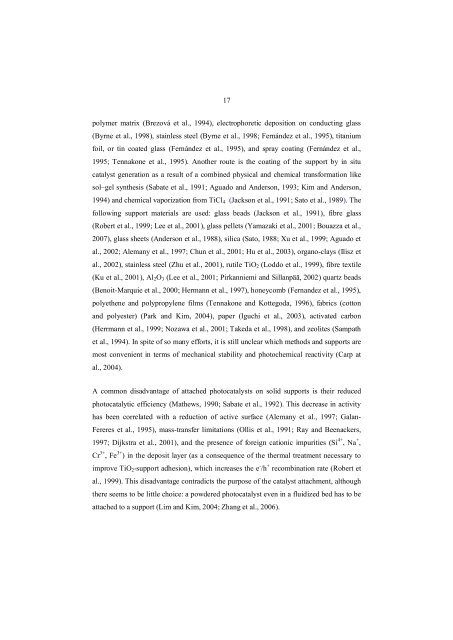gas-phase photocatalytic oxidation of volatile organic ... - Doria
gas-phase photocatalytic oxidation of volatile organic ... - Doria
gas-phase photocatalytic oxidation of volatile organic ... - Doria
Create successful ePaper yourself
Turn your PDF publications into a flip-book with our unique Google optimized e-Paper software.
17<br />
polymer matrix (Brezová et al., 1994), electrophoretic deposition on conducting glass<br />
(Byrne et al., 1998), stainless steel (Byrne et al., 1998; Fernández et al., 1995), titanium<br />
foil, or tin coated glass (Fernández et al., 1995), and spray coating (Fernández et al.,<br />
1995; Tennakone et al., 1995). Another route is the coating <strong>of</strong> the support by in situ<br />
catalyst generation as a result <strong>of</strong> a combined physical and chemical transformation like<br />
sol–gel synthesis (Sabate et al., 1991; Aguado and Anderson, 1993; Kim and Anderson,<br />
1994) and chemical vaporization from TiCl4 (Jackson et al., 1991; Sato et al., 1989). The<br />
following support materials are used: glass beads (Jackson et al., 1991), fibre glass<br />
(Robert et al., 1999; Lee et al., 2001), glass pellets (Yamazaki et al., 2001; Bouazza et al.,<br />
2007), glass sheets (Anderson et al., 1988), silica (Sato, 1988; Xu et al., 1999; Aguado et<br />
al., 2002; Alemany et al., 1997; Chun et al., 2001; Hu et al., 2003), organo-clays (Ilisz et<br />
al., 2002), stainless steel (Zhu et al., 2001), rutile TiO2 (Loddo et al., 1999), fibre textile<br />
(Ku et al., 2001), Al2O3 (Lee et al., 2001; Pirkanniemi and Sillanpää, 2002) quartz beads<br />
(Benoit-Marquie et al., 2000; Hermann et al., 1997), honeycomb (Fernandez et al., 1995),<br />
polyethene and polypropylene films (Tennakone and Kottegoda, 1996), fabrics (cotton<br />
and polyester) (Park and Kim, 2004), paper (Iguchi et al., 2003), activated carbon<br />
(Herrmann et al., 1999; Nozawa et al., 2001; Takeda et al., 1998), and zeolites (Sampath<br />
et al., 1994). In spite <strong>of</strong> so many efforts, it is still unclear which methods and supports are<br />
most convenient in terms <strong>of</strong> mechanical stability and photochemical reactivity (Carp at<br />
al., 2004).<br />
A common disadvantage <strong>of</strong> attached photocatalysts on solid supports is their reduced<br />
<strong>photocatalytic</strong> efficiency (Mathews, 1990; Sabate et al., 1992). This decrease in activity<br />
has been correlated with a reduction <strong>of</strong> active surface (Alemany et al., 1997; Galan-<br />
Fereres et al., 1995), mass-transfer limitations (Ollis et al., 1991; Ray and Beenackers,<br />
1997; Dijkstra et al., 2001), and the presence <strong>of</strong> foreign cationic impurities (Si 4+ , Na + ,<br />
Cr 3+ , Fe 3+ ) in the deposit layer (as a consequence <strong>of</strong> the thermal treatment necessary to<br />
improve TiO2-support adhesion), which increases the e - /h + recombination rate (Robert et<br />
al., 1999). This disadvantage contradicts the purpose <strong>of</strong> the catalyst attachment, although<br />
there seems to be little choice: a powdered photocatalyst even in a fluidized bed has to be<br />
attached to a support (Lim and Kim, 2004; Zhang et al., 2006).

















